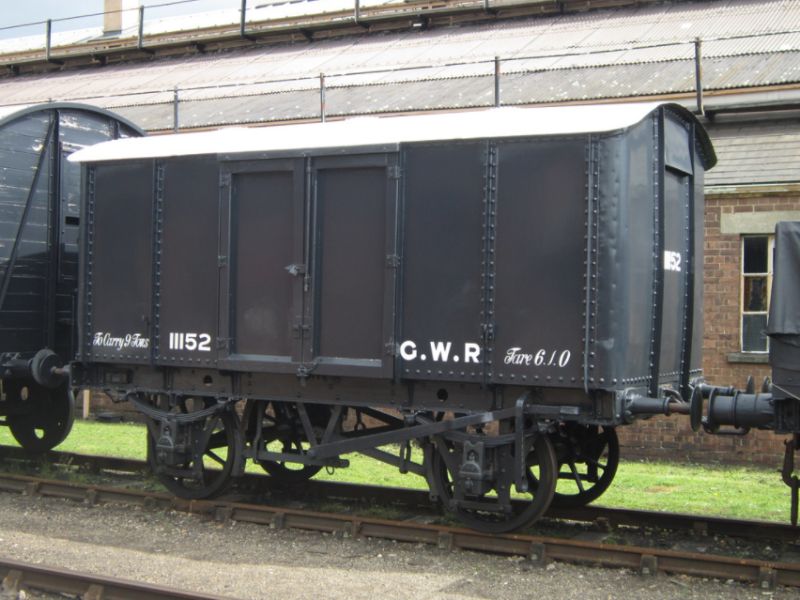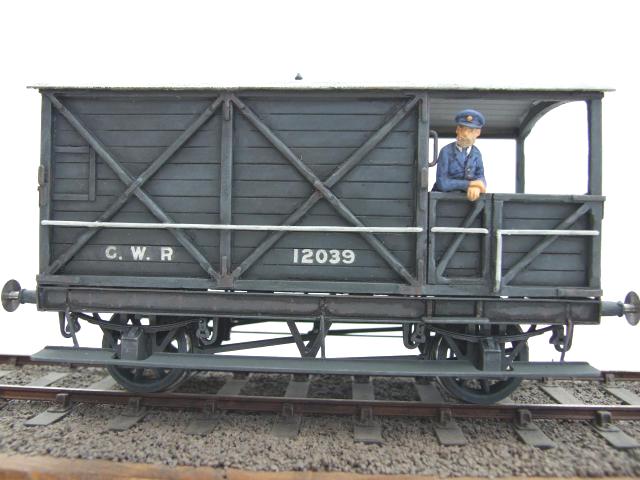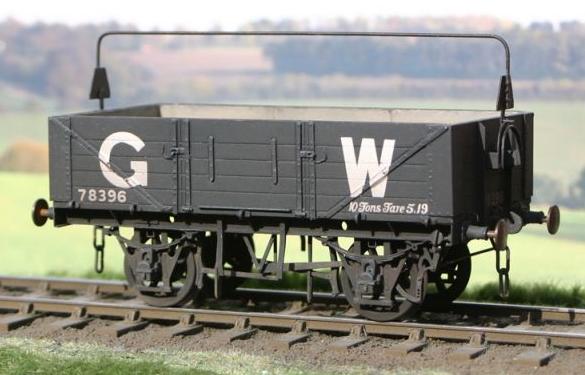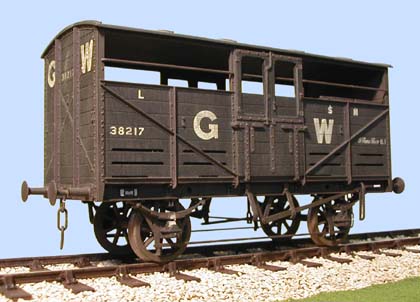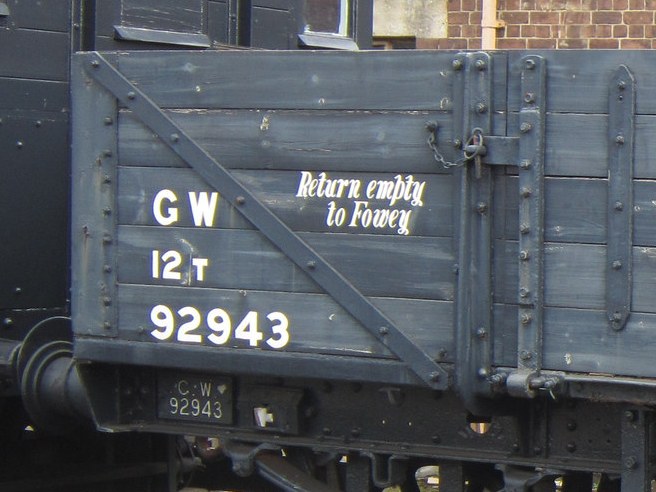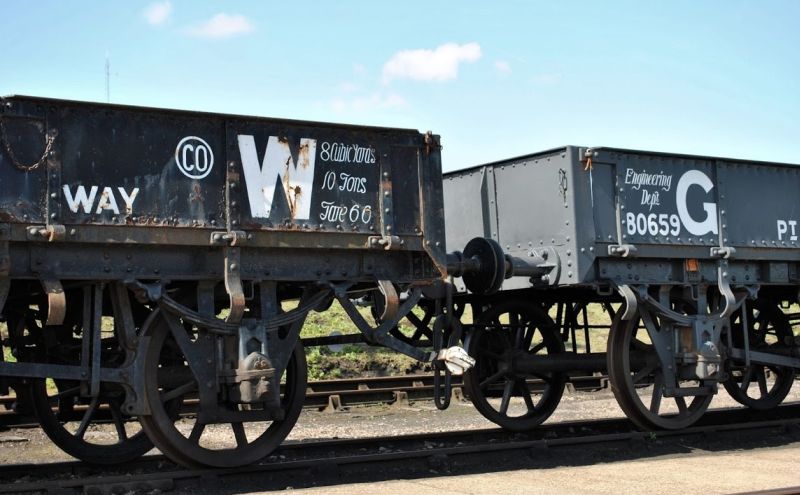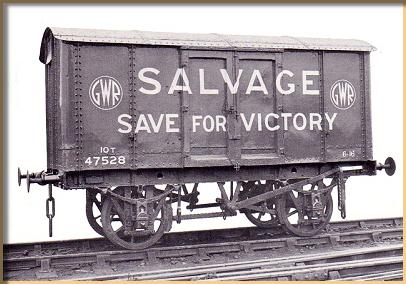| Section Page | Previous Page | Next Page |
GWR standard goods stock livery
Black and white mixed in the ratio of 7:1 (rgb 32,32,32; hex: #202020) The exact shade of the dark grey is somewhat unknown, but is likely to have varied. It is thought the GWR used a mix of black to white in a 7:1 ratio. Didcot Railway Centre uses a mix in a 14:1 ratio, but this is intentionally overdark to allow for the effects of ageing and fading. Precision Paints P19 is generally regarded as a good 'ex-works' colour. Goods vehicles were rarely, if ever, cleaned, and in service the grey would fade considerably and get a lot grubbier. Van roofs were painted all-over white until 1939, but as they were never washed they quickly turned a dirty grey. From 1939, the GWR finally gave in and painted roofs on newly-built stock all-over grey. The insides of open wagons, and interiors of vans and cattle wagons, were unpainted. The earliest lettering on grey-liveried GWR wagons took the form of 5" white G. W. R lettering painted directly on the wagon, along with tare numbers etc. From c 1894, lettering and numbers on some newly built wagons were carried on cast plates. The cast plates continued until c 1904, but contemporary photographic evidence indicates that the use of the cast plates never became widespread. Running numbers were also carried on the ends, a practice thought to have started c 1893. Wagon lettering and numbering was done by hand, so some variation in the precise shape of the characters could be seen, although much use was made of stencils, also known as 'pouncing'. A pounce is made from a piece of oiled card perforated with a needle to give a dotted outline, the card then being patted with a muslin bag filled with French Chalk which goes through the holes.
In 1904, large 25" G W lettering was introduced. Where there was not enough room to use this size of lettering because of outside wooden framing, 16" was used. For 2- and 3-plank wagons, 14" lettering was initially used, although most 3-plank wagons seem to have adopted the 16" size later. 4-plank opens had 16" lettering. On some wagons, e.g. the diagram W2 cattle wagon, the sides had 16" lettering and the ends had 25" lettering. The weight, e.g. '10 Tons' and the tare, e.g. 'Tare 5.7' were in 2.5" italic script. The '25" era' lasted until c 1921 when 16" lettering became standard. Running numbers continued to be 5" size. (The changeover from 25" to 16" G W lettering was specified in the CME's Circular 3627 of 17 August 1921.) Numbers on the ends were placed in the centre, unless there was insufficient visible space on the centre panel, either because of a vertical vacuum pipe or where a sheet supporter is mounted low on the wagon end, in which case the number appeared on the left panel. Numbers on the ends of new build general purpose vehicles ceased c 1929.
Some goods brake vans had a white star or a white 'S' below the depot allocation to indicate they had been weighted to 25T. Further details. The general service vehicles never saw use of the GWR Roundel when this was introduced in 1934, and 5" white letters were re-introduced in 1936/7 for the 'G W' and the running number on all grey stock. The word 'Tare' was no longer applied and the weight was simply written in the form of e.g. '5.7'. The size of the load and the tare numbers was reduced to 2". In 1942, the height of the 'G W' and the running number was reduced further to 3". These post-1937 sizes applied only to new build stock or where an existing wagon required repainting. The lack of resources in the run up to and during WWII meant comparatively few wagons were repainted after 1937, and many wagons carried their pre-1937 16" G W lettering into the post-nationalisation era.
Some special vehicles had variations in livery design. Cattle wagons were among the few types to have the 'G W' on the ends also, as seen above. Meat Vans were of a different colour scheme altogether, being white with red lettering. Some water tanks of the DD1 diagram were painted white. DD diagram gas and oil tanks were black. The experts are still arguing when, and even if, all-black became the livery for permanent way, loco coal, and engineering wagons, but the prevailing view is that such vehicles probably carried normal grey livery.
In the latter part of WWII, new goods vehicles are reported to have been painted in a reddish-brown colour, probably the same colour as that being applied for coach repaints from 1942–5, with open wagons being mostly bare wood with reddish-brown patches for markings. It is likely this livery applied only to new vehicles – repainting of older stock was most improbable. The normal grey livery was resumed after the war.
|
| Section Page | Previous Page | Next Page |
